Excerpts from Jim Conrad's
Naturalist Newsletter
from the October 23, 2016 Newsletter issued from Rancho Regenesis in the woods ±4kms west of Ek Balam Ruins; elevation ~40m (~130 ft), N20.876°, W88.170°; north-central Yucatán, MÉXICO
WILD TAMARIND
Over the years I've eaten lots of Wild Tamarind beans because they make decent snacks in the field and the species is common in much of Mexico. In the arid Yucatan, where it's called Uaxim (wa-SHEEM), it may be the most abundant of all tree species. Wild Tamarind is LEUCAENA LEUCOCEPHALA. One reason for its proliferation is that it thrives in disturbed habitats. In our area often it forms almost pure stands below power lines where the vegetation periodically is chopped away, and it's a pioneer species in abandoned cornfields being invaded by woody plants. Below, you can see a pure stand of young Wild Tamarinds along the paved road into Ek Balam town , and beneath a power line -- maybe 80% of the greenery there being Wild Tamarind:
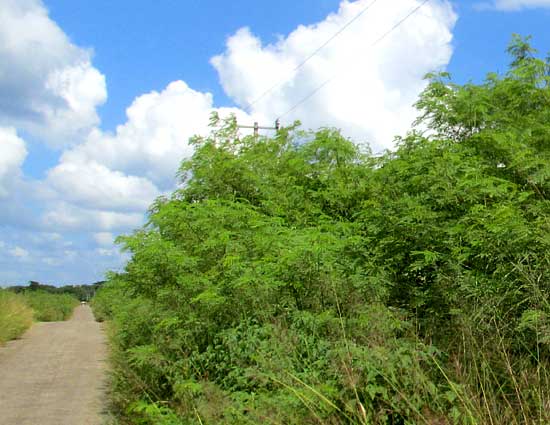
The local Maya are surprised when I tell them they can eat Wild Tamarind beans, but not impressed. For them, the beans are too small to bother with. To the Maya, Wild Tamarind gains respect by providing nutritious leaves and young woody branches that livestock like to eat. Here at the rancho most Wild Tamarind trees have had their branches hacked off several times to provide meals for burros and cattle. When a Wild Tamarind loses its limbs it immediately begins sprouting a thick crop of new ones, as shown below:

Wild Tamarind's twice-pinnately compound leaves are similar not only to those of the regular Tamarind, but also to acacia and mimosa leaves, as you can better see below:
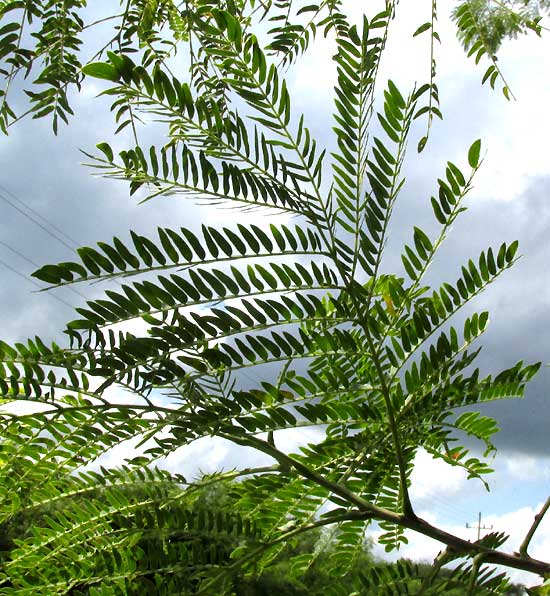
The species also produces small, spherical heads of white flowers, the same as do many acacia and mimosa species, as shown below:
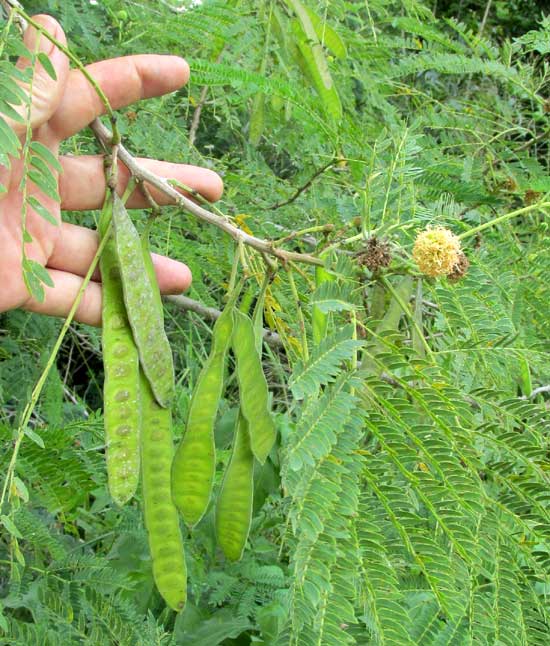
Therefore, why isn't Wild Tamarind considered an acacia or a mimosa?
Its flowers are unlike those of acacia species because each acacia blossom bears more than ten stamens, while both Wild Tamarind and mimosa species have ten or fewer stamens. Wild Tamarind can be differentiated from species of mimosa because mimosa flowers have corollas with four corolla lobes and four sepals, while Wild Tamarind's corolla lobes and sepals number five. Below, you can see some individual Wild Tamarind flowers
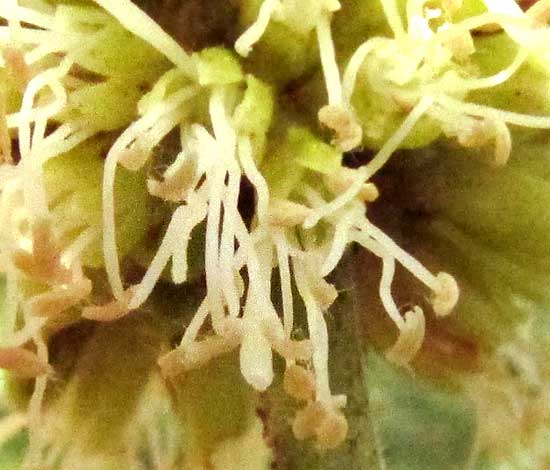
from the May 24, 2018 Newsletter issued from Rancho Regenesis in the woods ±4kms west of Ek Balam Ruins; elevation ~40m (~130 ft), N~20.876°, W~88.170°; central Yucatán, MÉXICO
WILD TAMARIND SEEDLINGS
Last week I described the abundant and ubiquitous Wild Tamarind's pioneer status in the ecological process of forest succession in the Yucatan. Here at the rainy season's beginning, Wild Tamarind seedlings are popping up everywhere, including in the garden. Since Wild Tamarind seedlings are so important ecologically, it's worth paying attention to them. Below, you can see one with its two photosynthesizing cotyledons, between which the seedling's first regular leaves are emerging, looking like a green feather

Many seed types are germinating, but it's easy to distinguish the Wild Tamarind's by their fairly large size/ tongue shape, yellowish-green color, and by the backward-projecting, sharp-tipped ears, or auricles, on each side of each cotyledon's base.
In a couple of days, the seedling's true leaves expand to the point that they begin looking like real compound leaves, as you can see on the left in the picture below:
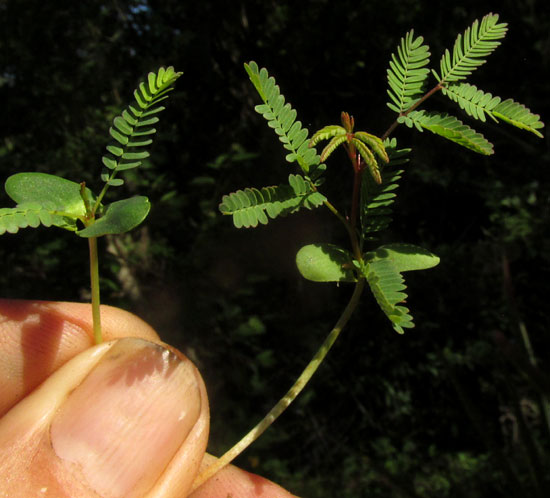
Interestingly, those first two leaves are only once pinnately compound, like locust leaves. However, Wild Tamarind's mature leaves are twice compound, like acacia leaves. In the above picture, the seedling at the right has developed more typical twice-compound leaves
When these two seedlings were uprooted for the photograph, a familiar odor wafted around me, apparently issuing from the injured roots. The odor perfectly matched the bitter-garlic taste of the Wild Tamarind's half-mature edible beans.
Recently I was studying aphids on various plants and noted that the tiny sap-sucking insects infested numerous species, but not Wild Tamarinds, even when they grew entangled among infested plants. Now I'm wondering if this strong taste in the beans, and the odor of the injured roots, arises from a chemical compound that might be tasty to a hungry human, but toxic to a sap-sucking insect.
from the March 19, 2017 Newsletter issued from Rancho Regenesis in the woods ±4kms west of Ek Balam Ruins; elevation ~40m (~130 ft), N20.876°, W88.170°; north-central Yucatán, MÉXICO
COPPICING WILD TAMARIND
Near Ek Balam recently some men set about cutting a large area of forest, leaving only the scattered trunks of decapitated small trees. Very soon these trunks sprouted numerous sprouts, as you can see below:

A close-up of some of the sprouting trunks is shown below:
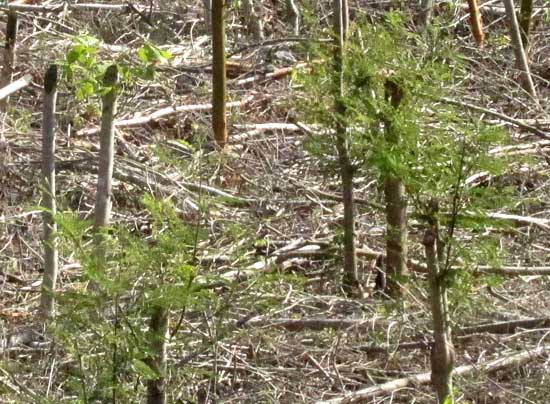
Now I understand that when the forest was cut the remaining lower trunks were those of Wild Tamarind trees. Apparently the trunks' sprouts are meant to supply livestock feed.* During this very hot, dry season the herbaceous layer has died back, and deciduous trees have lost most or all of their leaves, so free livestock food is hard to find.
The practice of cutting back trees to encourage new growth is called coppicing, and it's an old technique currently gaining recognition around here. I've not seen it done here on such a large scale before. At the ranch our Wild Tamarinds are coppiced to encourage sprouts for the livestock, but we don't have large fields of them like this.
I have mixed feelings about the process. On the one hand, it's using a native, locally grown plant as food for livestock. On the other hand, it's converting forest composed of diverse species into a monoculture, which is ecologically unstable and not nearly as useful to wildlife as regular forest.
It's all being done to feed livestock. The most ecologically friendly approach is for people to stop eating animal flesh, and leave the forests as they are.
from the October 10, 2017 Newsletter issued from Rancho Regenesis in the woods ±4kms west of Ek Balam Ruins; elevation ~40m (~130 ft), N20.876°, W88.170°; north-central Yucatán, MÉXICO
UNCOPPICING THE MAYA
After posting the above coppicing piece I began noticing that most Maya farmers here were burning their fields before the waist-tall, cut stems could produce sprouts. This killed the stems, making coppicing impossible.
Now I realize that the local Maya are not coppicing at all. They leave those Wild Tamarind stems cut off at waist height just because it's easiest to do so with a chainsaw. Even the farmers I saw cutting fresh growth didn't collect the cut stems and feed them to their livestock but rather let them lie on the ground, where they dried up and were burned later along with all other cut-down trees and bushes. I suppose the thinking is that Wild Tamarind is so ubiquitous along roadsides, that if a farmer wants livestock feed from the tree, it's easiest to stand on the road's pavement and with a machete hack and bundle what they want.
Coppicing is still an important practice. On wasteland or semi-desert land, when sprout-producing trees like Wild Tamarind are planted, not only is the soil stabilized and enriched, but the cut trunks' sprouts make great animal fodder.
It's just that the local Maya don't do it.
from the October 10, 2017 Newsletter issued from Rancho Regenesis in the woods ±4kms west of Ek Balam Ruins; elevation ~40m (~130 ft), N20.876°, W88.170°; north-central Yucatán, MÉXICO
WILD TAMARIND AS AN ECOLOGICAL PIONEER
The other day I climbed atop the rancho's new cement water tower and was mightily impressed by this tree. In every direction, over 360°, I saw approximately what shown below:

In the photo, the paler, yellowish-green trees up front are Wild Tamarinds. The darker trees in the back are larger trees of other species. The above picture shows where the rancho's property ends -- it ends with the Wild Tamarinds -- and other properties begin. Wild Tamarinds dominate on the rancho's property because about 15 years ago cattle roamed the ranch's grassy, scrubby fields. Once the ranch became unproductive, the land was allowed to "go wild." And, ecologically, Wild Tamarinds are "pioneer species," meaning that when such land is abandoned to Nature, Wild Tamarind is in the first wave of invading trees.
One reason Wild Tamarind is such a successful pioneer species is suggested in a picture taken of the top of a Wild Tamarind tree just below the tank, shown below:
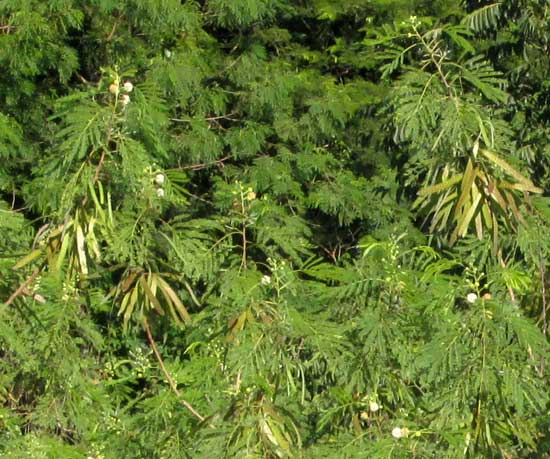
The trees are just loaded with legume-type fruits filled with numerous seeds. And even as legumes below the branches' tips are maturing, nearer the tips vigorous new flowering heads are forming. The tree floods the landscape with prodigious numbers of seeds.
Mature seeds are similar to lentils, but bone-hard. I'm unsure whether the main dispersal agent is birds, or the legumes themselves. Conceivably, when wind shakes the dry, split-open legumes, the legumes' movements might toss the seeds a fair distance.
Being members of the Bean Family, Wild Tamarind's roots put usable nitrogen into the soil. Once Wild Tamarind has grown in a spot for several years, its decaying leaves will have introduced organic matter into the soil, enabling the soil to better hold both water and nutrients. The newly enriched soil will be attractive to other tree species, which will invade Wild Tamarind strongholds. Wild Tamarind, despite its aggressive invasion of abandoned land, doesn't compete well with such invading species, and gradually is replaced by them.
Though for a year I've been walking through the rancho's young forest, it hadn't occurred to me that Wild Tamarind so dominated the forest's structure. That's because the forest understory here is home to a large number of invading trees, bushes and vines, and not many Wild Tamarinds.
from the March 3, 2007 Newsletter issued from Sierra orda Biosphere Reserve, Jalpan, Querétaro, MÉXICO
DON GONZALO EATING GUAJE BEANS
The other day Don Gonzalo ambled past my door nibbling on a thin, flat bean pod. You can see the whole thing below:
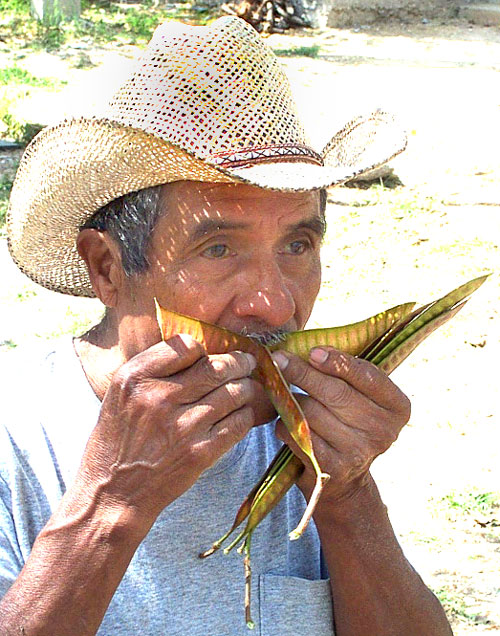
The Don flashed that big smile of his and asked me if I knew what he was eating. I surprised him by saying, "Sure, that's Guaje (GWA-heh), grows all over the place." I only knew this because Guaje, LEUCAENA LEUCOCEPHALA, was one of the most common roadside trees back in the Yucatan, where the Maya called it Uaxim (WA-sheem). In English it has a host of names, including Leadtree, White Popinac and Wild Tamarind.
This is the very season for nibbling Guaje beans, for the full-size beans are soft only for a brief time. Most of the year the trees with their twice-compound (bipinnate) leaves bear neither flowers nor fruits, or have only flowers, or else the fruits' matured seeds are too hard to eat. Now Guaje trees are heavy with soft-seeded, semi-mature legumes, as you can see below:
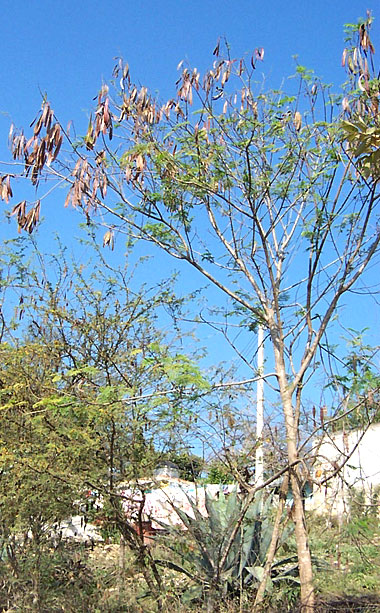
That picture also gives a good idea of the ragged appearance of many trees in our area right now, here in the heart of the dry season: Mostly leafless, but with a few old leaves, and a few new leaves, and often loaded with brown fruit pods.
Semi-mature Guaje seeds such as Don Gonzalo is eating have a sharp, almost bitter taste you need to be in a particular mind to enjoy. A kid wouldn't bother with it. However, good cooks know how to use the pungency when preparing special soups and sauces. On the Internet I find a gourmet site praising a meal of "Gunthorp duck breast with guasmole (Pueblan mole of roasted tomatillos and guaje seeds), bacon-studded sweet potato torta and cava-dressed Bayless Garden spicy greens."
I'll bet Don Gonzalo would sniff at such fancy fare, preferring his Guaje beans straight from the pod, and I have to say that I'm of the same mind.